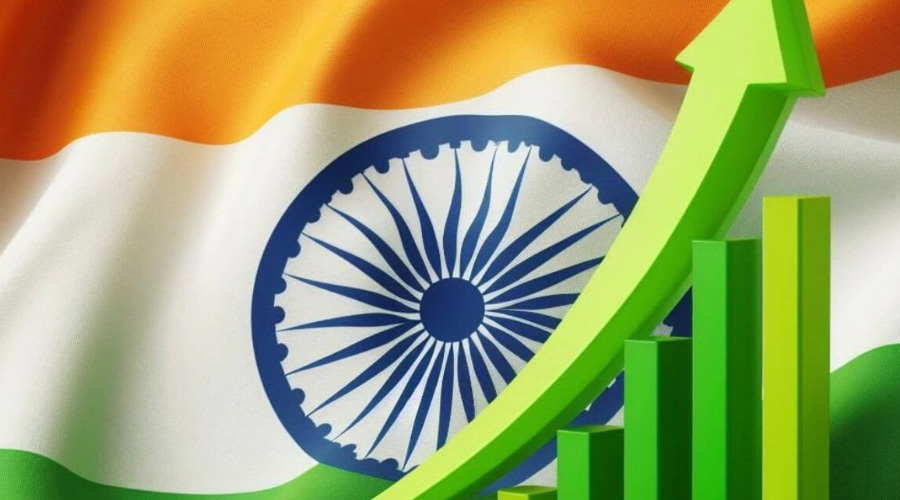Fourth-Largest Economy Status Creates New Risks Alongside Opportunities
Economic giants are born from storms of opportunity and challenge. India’s historic leap to a $4 trillion economy creates exactly this scenario. The nation just achieved the world’s fourth-largest economy while simultaneously entering its most vulnerable growth phase.
Success brings new problems that smaller economies never face. India now must navigate global influence alongside domestic transformation. This transition reveals investment opportunities and strategic risks that most analysts completely overlook in their celebration.
The Growth Foundation: Strong but Evolving
India achieved something remarkable in its economic history. The country doubled its GDP from US$2.1 trillion in 2015 to US$4.3 trillion in 2025. This represents 105 percent growth compared to 66 percent for the US and 76 percent for China during the same period.
The International Monetary Fund projects continued momentum toward third place by 2027. However, this growth pattern differs fundamentally from previous economic powers. Traditional giants built their foundations on diversified manufacturing bases. India concentrated heavily on services and technology instead.
This specialization created undeniable competitive advantages in global markets. Yet it also introduced dependency risks that economic downturns could expose quickly. The demographic dividend of 1.4 billion people provides sustainable domestic demand. But global integration means external shocks now impact India disproportionately. Success paradoxically increases vulnerability to forces beyond domestic control.
Services Supremacy: Innovation Engine or Structural Risk?
Services dominate India’s economic landscape with remarkable intensity. The sector contributes US$1.4 trillion to total GDP. Technology services alone target US$350 billion by 2026. Services exports are projected to reach US$800 billion by 2030.
These numbers reflect genuine competitive moats built over decades. Indian firms developed institutional knowledge and client relationships that competitors cannot replicate easily. The shift toward high-value consulting and specialized technology services creates sustainable profit margins. This reduces the commoditization risks that plagued earlier outsourcing models.
Artificial intelligence and automation, however, threaten this foundation. The critical insight involves timing and adaptation speed. India’s services evolution must accelerate faster than technological disruption occurs. Companies investing in AI integration will thrive. Those clinging to traditional outsourcing models face obsolescence within this decade.
Smart investors recognize bifurcated opportunities emerging from this transition. Back firms leading technological adaptation. Avoid companies trapped in legacy business models. The US$800 billion target remains achievable through continuous innovation rather than linear extrapolation.
Manufacturing Renaissance: Late Entry Advantage or Missed Window?
Manufacturing presents India’s most complex strategic challenge. The sector reached $418 billion in exports with an impressive 15 percent compound annual growth. Production-Linked Incentive schemes target US$1 trillion by FY26. Electronics exports to America alone jumped from US$10 billion to $80 billion by 2030.
Global companies genuinely seek alternatives to Chinese manufacturing dominance. India offers competitive labor costs and improving infrastructure support. Government policies actively encourage foreign investment. Domestic consumption provides built-in demand that reduces export dependency significantly.
Timing creates substantial obstacles, though. Supply chain regionalization now favors proximity over pure cost efficiency. Mexico benefits US markets while Eastern Europe captures European demand. India’s geographical distance requires superior productivity and quality standards to compete effectively.
The winning strategy targets specific sectors for leadership positions. Pharmaceuticals offer established advantages. Chemicals and precision manufacturing show strong potential. Commodity electronics and basic textiles face intense competition with limited differentiation opportunities.
Global Integration: Power and Peril
Systemic importance brings both privileges and dangers. India’s projected contribution of 18 percent to global growth positions the nation as economically critical. This status creates influence in international forums. Investment flows naturally seek exposure to such growth dynamics.
The flip side involves amplified vulnerability to global shocks. Trade tensions with America could push tariffs to 28.2 percent on Indian exports. Economic size attracts negative attention alongside positive investment interest. Currency markets reveal underlying skepticism about sustainability.
The rupee continues weakening against the US dollar despite crossing the US$4 trillion threshold. This suggests investors remain cautious about structural challenges. Market dynamics often provide more honest assessments than official projections.
Global capability centers and foreign partnerships reflect genuine confidence in long-term prospects. Yet geopolitical tensions create new risks that smaller economies typically avoid entirely.
The Investment Thesis: Selective Optimism
India’s trajectory toward US$7 trillion by 2030 remains achievable with proper execution. Success requires navigating structural transitions that separate winners from laggards. Technology companies embracing AI integration have the strongest prospects. Manufacturing companies capable of building specialized capabilities stand to do very well. Infrastructure development companies targeting next-generation systems present attractive opportunities.
Even with a broad, growing economy, traditional outsourcing faces headwinds. Commodity manufacturing has no sustainable advantages. Investments in legacy infrastructure may become stranded assets amid fast-paced change.
Any smart investor needs to take a sophisticated approach by analyzing specific companies rather than the projected trend in India’s growth story broadly. Markets that grasp this will make an investment that would be utterly missed by surface-level analysis.
Conclusion
India’s achievement signifies a fundamental change in the economic balance worldwide. Big economies face different challenges from those peculiar to emerging markets. The US$4 trillion milestone marks graduation to a more complex, competitive landscape.
Technology disruption will decide which sectors in India will win and which will simply survive the transition. During the manufacturing growth period, winners specialize rather than compete against broad competition across all categories.
The currency weakness, therefore, suggests that underlying structural adjustments have yet to go through despite the impressive headline growth numbers. Smart investors further focus on execution capabilities when evaluating opportunities, rather than the simple size metrics.



































